![]()
 Last summer on a trip to Canada I picked up a copy of Darren Wershler-Henry’s The Iron Whim: a Fragmented History of Typewriting. It’s a look at our relationship with one particular piece of technology through a compound eye, investigating why so many books striving to be “literary” have typewriter keys on the cover, novelists’ feelings for their typewriters, and the complicated relationship between typewriter making and gunsmithing, among a great many other things. The book ends too soon, as Wershler-Henry doesn’t extend his thinking about typewriters and writing into broader conclusions about how technology affects writing (for that see Hugh Kenner’s The Mechanic Muse) but it’s still worth tracking down.
Last summer on a trip to Canada I picked up a copy of Darren Wershler-Henry’s The Iron Whim: a Fragmented History of Typewriting. It’s a look at our relationship with one particular piece of technology through a compound eye, investigating why so many books striving to be “literary” have typewriter keys on the cover, novelists’ feelings for their typewriters, and the complicated relationship between typewriter making and gunsmithing, among a great many other things. The book ends too soon, as Wershler-Henry doesn’t extend his thinking about typewriters and writing into broader conclusions about how technology affects writing (for that see Hugh Kenner’s The Mechanic Muse) but it’s still worth tracking down.
It did start me thinking about my use of technology. Back in junior high I was taught to type on hulking IBM Selectrics, but the last time I’d used a typewriter was to type up my college application essays. (This demonstrates my age: my baby brother’s interactions with typewriters have been limited to once finding the family typewriter in the basement; though he played with it, he says that he “never really produced anything of note on it,” and he found my query about whether or not he’d typed his college essays so ridiculous as not to merit reply.) Had I been missing out? A little investigation revealed a thriving typewriter market on eBay; for $20 (plus shipping & handling) I bought myself a Hermes Baby Featherweight. With a new ribbon and some oiling it works well, though it’s probably from the 1930s.
 Next I got myself a record player. I would like to note that this acquisition didn’t immediately follow my buying a typewriter: old technology isn’t that slippery a slope. This was because I happened to see a record player that was cute as a button (a Numark PT-01) and cheap. It’s also because much of the music I’ve been listening to lately doesn’t get released on CD: dance music is still mostly vinyl-based, though it’s made the jump to MP3s without much trouble. There wasn’t much reasoning past that: after buying my record player I started buying records, almost all things I’d previously heard as MP3s. And, of course, I’d never owned a record player and I was curious what it would be like.
Next I got myself a record player. I would like to note that this acquisition didn’t immediately follow my buying a typewriter: old technology isn’t that slippery a slope. This was because I happened to see a record player that was cute as a button (a Numark PT-01) and cheap. It’s also because much of the music I’ve been listening to lately doesn’t get released on CD: dance music is still mostly vinyl-based, though it’s made the jump to MP3s without much trouble. There wasn’t much reasoning past that: after buying my record player I started buying records, almost all things I’d previously heard as MP3s. And, of course, I’d never owned a record player and I was curious what it would be like.
![]()
So what happened when I started using this technology of an older generation? The first thing you notice about using a typewriter (and I’m specifically talking about using a non-electric typewriter) is how much sense it makes. When my typewriter arrived, it was filthy. I scrubbed the gunk off the top, then unscrewed the bottom of it to get at the gunk inside it. Inside, typewriters turn out to be simple machines. A key is a lever that triggers the hammer with the key on it. The energy from my action of pressing the key makes the hammer hit the paper. There are some other mechanisms in there to move the carriage and so on, but that’s basically it.
 A record player’s more complicated than a typewriter, but it’s still something that you can understand. Technologically, a record player isn’t very complicated: you need a motor that turns the record at a certain speed, a pickup, something to turn the vibrations into sound, and an amplifier. Even without amplification, the needle in the groove makes a tiny but audible noise: this guy has made a record player out of paper. If you look at the record, you can see from the grooves where the tracks begin and end; quiet passages don’t look the same as loud passages. You don’t get any such information from a CD: a burned CD looks different depending on how much information it has on it, but the bottom from every CD from the store looks completely identical. Without a label, you can’t tell whether a disc is an audio CD, a CD-ROM, or a DVD.
A record player’s more complicated than a typewriter, but it’s still something that you can understand. Technologically, a record player isn’t very complicated: you need a motor that turns the record at a certain speed, a pickup, something to turn the vibrations into sound, and an amplifier. Even without amplification, the needle in the groove makes a tiny but audible noise: this guy has made a record player out of paper. If you look at the record, you can see from the grooves where the tracks begin and end; quiet passages don’t look the same as loud passages. You don’t get any such information from a CD: a burned CD looks different depending on how much information it has on it, but the bottom from every CD from the store looks completely identical. Without a label, you can’t tell whether a disc is an audio CD, a CD-ROM, or a DVD.
![]()
 There’s something admirably simple about this. On my typewriter, pressing the A key always gets you the letter A. It may be an uppercase A or a lowercase a, but it’s always an A. (Caveat: if it’s oiled and in good working condition and you have a good ribbon. There are a lot of things that can go wrong with a typewriter.) This is blatantly obvious. It only becomes interesting when you set it against the way we type now. If I type an A key on my laptop, sometimes an A appears on my screen. If my computer’s set to use Arabic or Persian input, typing an A might get me the Arabic letter ش. But if I’m not in a text field, typing an A won’t get me anything. Typing A in the Apple Finder, for example, selects a file starting with that letter. Typing an A in a web browser usually doesn’t do anything at all. On a computer, the function of the A key is context-specific.
There’s something admirably simple about this. On my typewriter, pressing the A key always gets you the letter A. It may be an uppercase A or a lowercase a, but it’s always an A. (Caveat: if it’s oiled and in good working condition and you have a good ribbon. There are a lot of things that can go wrong with a typewriter.) This is blatantly obvious. It only becomes interesting when you set it against the way we type now. If I type an A key on my laptop, sometimes an A appears on my screen. If my computer’s set to use Arabic or Persian input, typing an A might get me the Arabic letter ش. But if I’m not in a text field, typing an A won’t get me anything. Typing A in the Apple Finder, for example, selects a file starting with that letter. Typing an A in a web browser usually doesn’t do anything at all. On a computer, the function of the A key is context-specific.
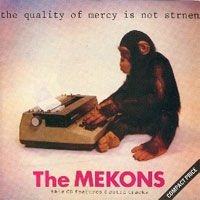 What my excursion into old technology makes me notice is how comparatively opaque our current technology is. It’s not hard to figure out how a typewriter works: were a monkey to decide that she wanted to write Hamlet, she could figure out how to use a typewriter without any problem. (Though I’m sure it exists, I couldn’t dig up any footage on YouTube of a monkey using a record player. This cat operating a record player bodes well for them, though.) It would be much more difficult, if not impossible, for even a monkey and a cat working together to figure out how to use a laptop to do the same thing.
What my excursion into old technology makes me notice is how comparatively opaque our current technology is. It’s not hard to figure out how a typewriter works: were a monkey to decide that she wanted to write Hamlet, she could figure out how to use a typewriter without any problem. (Though I’m sure it exists, I couldn’t dig up any footage on YouTube of a monkey using a record player. This cat operating a record player bodes well for them, though.) It would be much more difficult, if not impossible, for even a monkey and a cat working together to figure out how to use a laptop to do the same thing.
Obviously, designing technologies for monkeys is a foolish idea. Computers are useful because they’re abstract. I can do things with it that the makers of my Hermes Baby Featherweight couldn’t begin to imagine in 1936 (although I am quite certain than my MacBook Pro won’t be functional in seventy years). It does give me pause, however, to realize that I have no real idea at all what’s happening between when I press the A key and when an A appears on my screen. In a certain sense, the workings of my computer are closed to me.
![]()
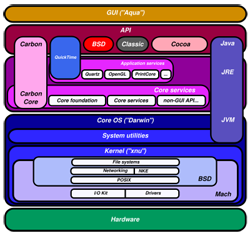
Let me add some nuance to a previous statement: not only are computers abstract, they have layers of abstraction in them. Somewhere deep inside my computer there is Unix, then on top of that there’s my operating system, then on top of that there’s Microsoft Word, and then there’s the paper I’m trying to write. (It’s more complicated than this, I know, but allow me this simplification for argument’s sake.) But these layers of abstraction are tremendously useful for the users of a computer: you don’t have to know what Unix or an operating system is to write a paper in Microsoft Word, you just need to know how to use Word. It doesn’t matter whether you’re using a Mac or a PC.
The world wide web takes this structure of abstraction layers even further. With the internet, it doesn’t matter which computer you’re on as long as you have an internet connection and a web browser. Thus I can go to another country and sit down at an internet café and check my email, which is pretty fantastic.
And yet there are still problems. Though everyone can use the Internet, it’s imperfect. The same webpage will almost certainly look different on different browsers and on different computers. This is annoying if you’re making a web page. Here at the Institute, we’ve spent ridiculous amounts of time trying to ascertain that video will play on different computers and in different web browsers, or wondering whether websites will work for people who have small screens.
A solution that pops up more and more often is Flash. Flash content works on any computer that has the Flash browser plugin, which most people have. Flash content looks exactly the same on every computer. As Ben noted yesterday, Flash video made YouTube possible, and now we can all watch videos of cats using record players.
But there’s something that nags about Flash, the same thing that bothers Ben about Flash, and in my head it’s consonant with what I notice about computers after using a typewriter or a record player. Flash is opaque. Somebody makes the Flash & you open the file on your computer, but there’s no way to figure out exactly how it works. The View Source command in your web browser will show you the relatively simple HTML that makes up this blog entry; should you be so inclined, you could figure out exactly how it worked. You could take this entry and replace all the pictures with ones that you prefer, or you could run the text through a faux-Cockney filter to make it sound even more ridiculous than it does. You can’t do the same thing with Flash: once something’s in Flash, it’s in Flash.
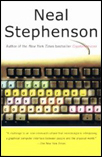 A couple years ago, Neal Stephenson wrote an essay called “In the Beginning Was the Command Line,” which looked at why it made a difference whether you had an open or closed operating system. It’s a bit out of date by now, as Stephenson has admitted: while the debate is the same, the terms have changed. It doesn’t really matter which operating system you use when more and more of our work is being done on web applications. The question of whether we use open or closed systems is still important: maybe it’s important to more of us, now that it’s about how we store our text, our images, our audio, our video.
A couple years ago, Neal Stephenson wrote an essay called “In the Beginning Was the Command Line,” which looked at why it made a difference whether you had an open or closed operating system. It’s a bit out of date by now, as Stephenson has admitted: while the debate is the same, the terms have changed. It doesn’t really matter which operating system you use when more and more of our work is being done on web applications. The question of whether we use open or closed systems is still important: maybe it’s important to more of us, now that it’s about how we store our text, our images, our audio, our video.


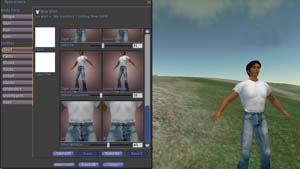 People around me have much more sophisticated outfits than I do. So, I try out the free clothing features. I darken my pants to a deep blue and my shoes black. Then, my default shirt gets turned into a loose white t-shirt. Somehow I end up a bit like a GAP model crossed with Max Headroom. After making my first “friend,” another complete stranger comes up to me and just starts giving me clothes. Apparently, my clothes still need a little work. I try on the cowboy boots and faded jeans. Happy that I’ve moved beyond the standard issue clothes, I thank my benefactor and begin to make my way to the event.
People around me have much more sophisticated outfits than I do. So, I try out the free clothing features. I darken my pants to a deep blue and my shoes black. Then, my default shirt gets turned into a loose white t-shirt. Somehow I end up a bit like a GAP model crossed with Max Headroom. After making my first “friend,” another complete stranger comes up to me and just starts giving me clothes. Apparently, my clothes still need a little work. I try on the cowboy boots and faded jeans. Happy that I’ve moved beyond the standard issue clothes, I thank my benefactor and begin to make my way to the event.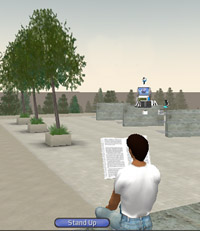 The interview is about to begin, as an avatar with large red wings walks by me. I say out loud, “I know she was going to sit in front of me.” Adding, “Just kidding,” in case I might be offending someone, who knows who this person could be. Fortunately, she found a seat outside my sight line without incident, and the introductory remarks began.
The interview is about to begin, as an avatar with large red wings walks by me. I say out loud, “I know she was going to sit in front of me.” Adding, “Just kidding,” in case I might be offending someone, who knows who this person could be. Fortunately, she found a seat outside my sight line without incident, and the introductory remarks began.